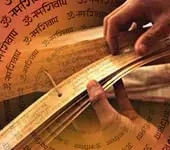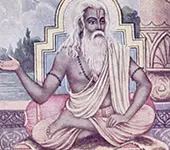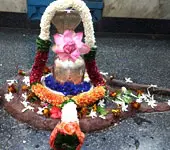This audio gives you a crystal clear explanation of what Tanmatra means.
Comments
What is the benefit of reciting Durga Saptashati?
Reciting Durga Saptashati will give you inner strength, self-control, and courage. It will protect you from dangers and remove obstacles from your path. Reciting Durga Saptashati on a regular basis will give you knowledge and enlightenment.
Is Bhagavad Gita part of the Vedas?
Bhagavad Gita is part of Mahabharata. It is also considered as Smriti - Upanishad.
Quiz
Who was Agastya Maharshi's father ?Transcript
(Click here to read more)
In darshanas, you will see this term Tanmatra. Shabda-sparsha-roopa-rasa-gandha Tanmatras. What exactly is Tanmatra? Take Shabda-Tanmatra for example. Of course, vibration produces sound. But vibration and sound are different. If there is no medium of transmission between the source of the vibration and the listener then there is no sound. But vibration is still there. Now, the power or listening varies from person to person. A trained ear can listen much much more than an ordinary ear. You mu....
Transcript
(Click here)
In darshanas, you will see this term Tanmatra.
Shabda-sparsha-roopa-rasa-gandha Tanmatras.
What exactly is Tanmatra?
Take Shabda-Tanmatra for example.
Of course, vibration produces sound.
But vibration and sound are different.
If there is no medium of transmission between the source of the vibration and the listener then there is no sound.
But vibration is still there.
Now, the power or listening varies from person to person.
A trained ear can listen much much more than an ordinary ear.
You must have seen the judges in those reality shows.
Even minor deviation in shruti or swara-sthana of the participants they can point out.
A sound engineer can detect very subtle hiss and hum in a recording even to specific frequencies and filter them out.
This is among humans.
There is an instrument called dog dazer used to chase away aggressive dogs.
We won't able to hear, but dogs can hear the vibrations coming from that.
They are unbearable for the dogs and they run away.
If the dog is deaf, it wouldn't matter.
With all these alterations possible, what we hear may not be even the original sound produced by the vibrations.
Earlier we saw sound being divided into para and aprara.
On top of the apara sounds, there was this perfect ear, which hears every sound, as it is, which doesn't distort sound.
What the perfect ear can hear, the pure undistorted sound is called Shabda-Tanmatra.
Sound fully in conformity with the source vibrations.
This is Shabda-Tanmatra.
Same with the other sensory organs also.
Sparsha, roopa, rasa, and gandha.
Touch, vision, taste, and smell.
Elsewhere we have seen earlier, how the sensitivity towards pleasure goes up in the higher realms of existence.
It is not that in Swargaloka there are enjoyments different from what we have on earth, I mean completely different.
They are the same- food, music experienced through the sensory organs.
But when you are in Swarga your sensitivity is much much more.
So if a Rasagulla is giving you pleasure of let's say 10 when on earth, the same Rasagulla will give you pleasure of 10,000 when in Swarga.
So going up and up in the ladder, when the sensitivity of the ear is perfect what it hears is Shabda-Tanmatra.
The original sound.
Without any distortion imposed by the ears or the auditory nerves or the auditory system.
Even the medium of transmission up to the ear, even that would distort sound.
If sound passes through water, it is distorted.
So pure sound is Shabda-Tanmatra.
What you end up hearing is just sound, shabda.
In yoga, there is a state called Vicharanugata-samprajnata-samadhi.
If this is perfected, the Tanmatras can be experienced to some extent.
That is at the level of the mind.
Without the need for any external source.
Recommended for you
There are quacks in the field of Vedas and Mantras also
 Click here to know more..
Click here to know more..
The life of a child is stressful
 Click here to know more..
Click here to know more..
Kalpeshwara Shiva Stotram

kalpeshvaram bhavabhayaartiharam prapadye. kalpadrumam pranatabhaktahri'dandhakaaram maayaavilaasamakhilam vinivartayantam. chitsooryaroopamamalam nij....
Click here to know more..
English Topics
Mantra Shastra
Click on any topic to open
- 35 Why There Are Different Mantras For The Same Devata
- 34 Is Idol Worship Only For Beginners?
- 33 The Symbolism Of Madhu Kaitabha Story
- 32 Agneyastra
- 31 What is a beeja mantra?
- 30 How Mantras Have Got The Power To Manifest
- 29 Mantras Are Targeted Vibrations
- 28 What exactly is Tanmatra?
- 27 What are the qualities of a Guru?
- 26 Awareness levels of vibrations
Please wait while the audio list loads..
30
Ganapathy
Shiva
Hanuman
Devi
Vishnu Sahasranama
Mahabharatam
Practical Wisdom
Yoga Vasishta
Vedas
Rituals
Rare Topics
Devi Mahatmyam
Glory of Venkatesha
Shani Mahatmya
Story of Sri Yantra
Rudram Explained
Atharva Sheersha
Sri Suktam
Kathopanishad
Ramayana
Mystique
Mantra Shastra
Bharat Matha
Bhagavatam
Astrology
Temples
Spiritual books
Purana Stories
Festivals
Sages and Saints
